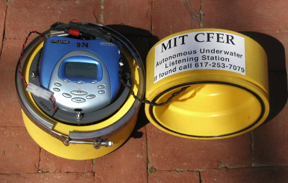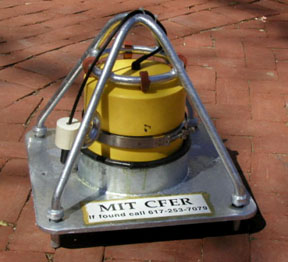

| Current Projects | Center for Marine Social Science | Center for Fisheries Engineering Research | FinFish Hatchery | GIS Workshop 2006 | Archives | |
MIT Sea Grant is committed to achieving and maintaining sustainability in fisheries and aquaculture through improved engineering of fishing systems, assessments of the economic and social impacts of regulations, increasing our understanding of the ecological significance of fishing and aquaculture, and developing better tools for determining the abundance and behavior of commercially important stocks. We are encouraging research that helps develop a comprehensive program for the successful integration of a commercial aquaculture industry in the Northeast. |
 |
CFER
Project Title: Passive Acoustic
Applications in Marine Fisheries Project
Summary Summary: In
the fall of 2002, the proposers began a project titled "The
Identification of Cod and Haddock Spawning Habitat Using Passive
Acoustics" sponsored by the Northeast Consortium. Under
this project we have developed innovative, low-cost Autonomous
Underwater Listening Stations (AULS). The AULS hardware is specifically
designed for deployment from commercial fishing vessels.They
are built around state-of-the-art digital recording devices know
as Nomad Jukeboxes by Creative Laboratories which employ 10 GB
hard drives to store over 60 hours of acoustic data.
Research Protocols The Nomad, gel cell, and custom interface circuitry fit into a compact pressure housing made from polyethylene gas pipe end caps machined to accommodate am O-ring and held together with a band clamp. The housings have been pressure tested to the equivalent of 250m of seawater. With an external hydrophone/preamplifier, the units cost under $1,000 each. Six AULS units have been built under the project and additional Nomad units are being used as replaceable storage media to shuttle data from the boats to MIT for uploading and processing. To facilitate the deployment of the AULS, galvanized steel bottom mounts have been built that weigh 60 pounds and protect the housing from impact by other fishing gear. Pictured in Figure 2, these units are rigged much like passive fishing gear, placed between two anchors and two surface floats. During April and May, we have taken advantage of know spawning grounds around Gloucester. In June, the fieldwork was expanded to the north with deployments out of Sebasco, Maine. To date, the placement
of the units has been based on the knowledge of the participating
fishermen of historical spawning aggregations, current catch
reports from commercial and recreational fishermen, and on bycatch
reports from lobstermen. The participating fishermen are also
using hook and line to verify the presence of fish.
The normal practice is to leave the AULS deployed for two days, then return to service the unit and redeploy it in the same or a nearby location. The Nomads will capture a maximum of 218 fifteen-minute files, or 54.5 hours of continuous two-channel data when set on its lowest 11,025 Hz., 12-bit sampling rate. The AULS units use HTI (High Tcch Industries, Gulfport, MS) hydrophones which have have built-in preamplifiers that provide sufficient gain to yield –165 dB per volt at 1 mPa. The Nomads have a user-adjustable gain setting from 1 to 15, which we leave on the highest setting. This combination provides excellent sensitivity, but which can saturate during deployment and retrieval, during the nearby passage of vessels, and during some marine mammal calls. During servicing, the Nomad, two 6-volt lead-acid gel cells, and two 9-volt transistor batteries for the hydrophone preamplifier are replaced. The Nomad is then returned to MIT for uploading and analysis. Uploading of the files takes approximately 4 hours using a USB port and Creative Laboratory’s file transfer software. We are using Cool Edit 2000 software (Centrillium) for our preliminary analysis. This process involves a visual inspection of the waveform of each 43,000 MB file and listening to passages that appear interesting or have the characteristics of fish sounds. We are working on developing an automatic identification system that will scan the files for sounds that match the acoustic parameters of species of interest. For this process, we are using Ishmael, a software developed at the Pacific Marine Environmental Laboratory for processing acoustic files (Mellinger 2002). Using spectrogram correlation (Mellinger and Clark 2000) we will soon be able to scan our recordings and have passages that match know vocalizations of cod and haddock identified and the statistics on their occurrence generated. Of course, there are much more than fish vocalizations captured by our broadband, omni-directional hydrophone. At times passing vessels or noise from weather-induced sea state dominate the acoustic environment and makes fish sound detection impossible.
|
 |
||

